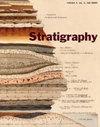Lower Miocene quantitative calcareous nannofossil biostratigraphy from the Tropical Atlantic
IF 0.9
3区 地球科学
Q3 GEOLOGY
引用次数: 0
Abstract
Quantitative analysis of the lower Miocene of Ocean Drilling Program Hole 959A from the West African margin was performed to document all the calcareous nannofossil biostratigraphic events present. Combined with data from previous investigations of the lower Miocene from the tropical Atlantic, this research identifies and tests the viability of markers used in current zonation schemes, recognizes alternative markers for age boundaries, and examines statistically the most probable order of events in the lower Miocene using the Ranking and Scaling method (RASC). In Hole 959A, all major zonal and subzonal boundaries from CN1 to CN4 were identified, except for the boundary between Subzones CN1a and CN1b, using primary and secondary markers from the Okada and Bukry (1980) zonation. In addition, all age boundaries from the Chattian to Langhian stages were recognized or closely estimated using the calcareous nannoplankton markers. The resultant list of events extracted from Hole 959Aalong with events from other seven sites were examined biostratigraphically using RASC. A well threshold of four was selected as an appropriate control parameter, resulting in 22 events in the optimum sequence, 13 of which had a low standard deviation. Furthermore, interpolation of ages of events using Age/Depth model for Hole 959A was examined. The extracted ages provided a reasonable preliminary age estimate for the secondary events.热带大西洋中新世下定量钙质纳米化石生物地层学
对西非边缘海洋钻探项目959A孔中新世下部进行了定量分析,记录了所有存在的钙质纳米化石生物地层事件。结合以往对热带大西洋中新世下部的调查数据,本研究确定并测试了当前分区方案中使用的标记的可行性,识别了年龄边界的替代标记,并使用排序和标度方法(RASC)对中新世下部最可能的事件顺序进行了统计检验。959A孔利用Okada和Bukry(1980)分区的主要和次要标记,除CN1a和CN1b亚分区之间的边界外,确定了CN1至CN4的所有主要分区和次分区边界。此外,利用钙质纳米浮游生物标记物识别或严密估计了夏天期至琅始期的所有年龄界限。利用RASC对995a孔和其他7个点的事件进行了生物地层学分析。选择4个井阈值作为适当的控制参数,得到了22个最优序列事件,其中13个具有低标准差。利用年龄/深度模型对959A孔的事件年龄进行插值。提取的年龄为次要事件提供了合理的初步年龄估计。
本文章由计算机程序翻译,如有差异,请以英文原文为准。
求助全文
约1分钟内获得全文
求助全文
来源期刊

Stratigraphy
地学-地质学
CiteScore
1.80
自引率
6.70%
发文量
0
审稿时长
>12 weeks
期刊介绍:
The journal’s mission is to publish peer-reviewed papers that use modern stratigraphic tools – biostratigraphy, chemostratigraphy, magnetostratigraphy, cyclostratigraphy, sequence stratigraphy, climatostratigraphy, lithostratigraphy, GSSPs and more – to explore broad ideas in earth history.
 求助内容:
求助内容: 应助结果提醒方式:
应助结果提醒方式:


